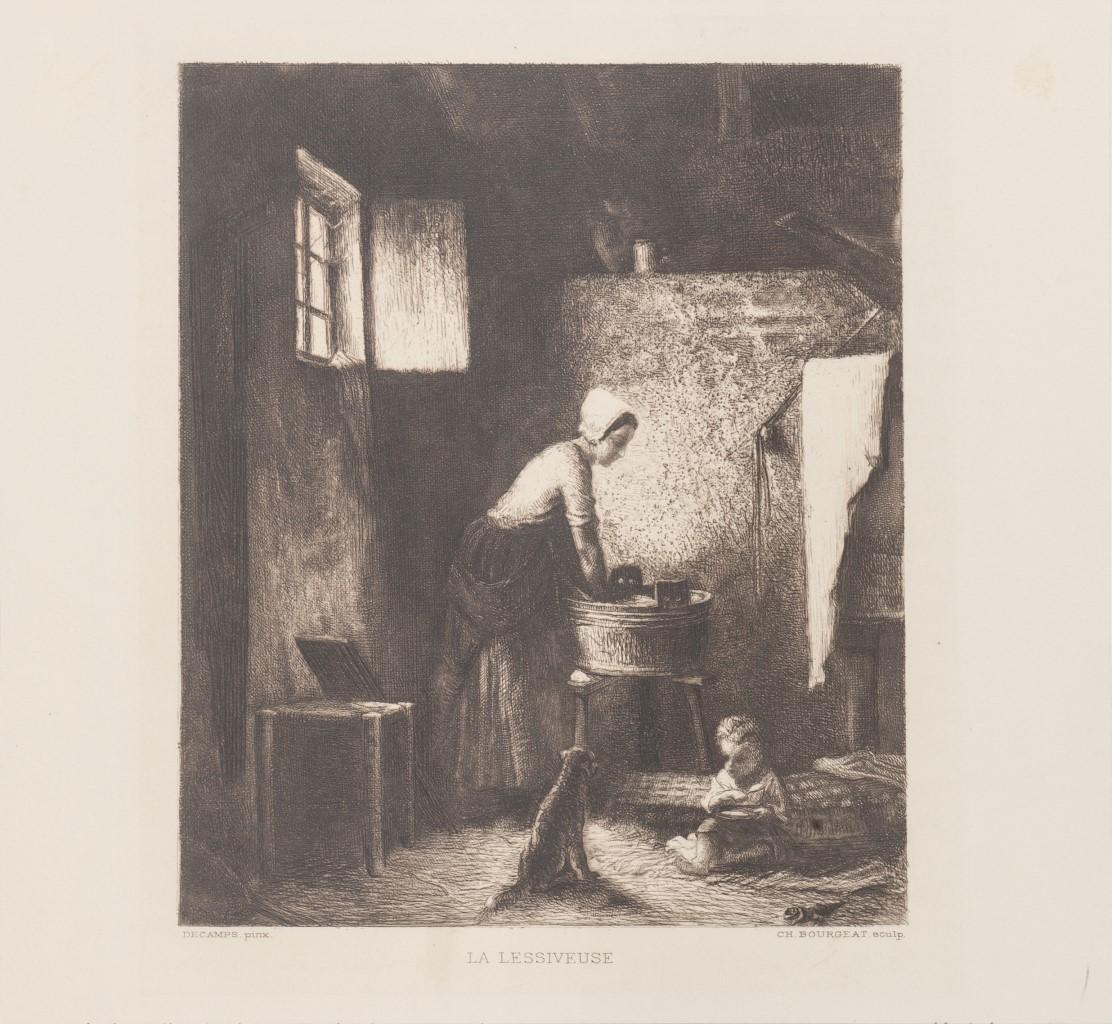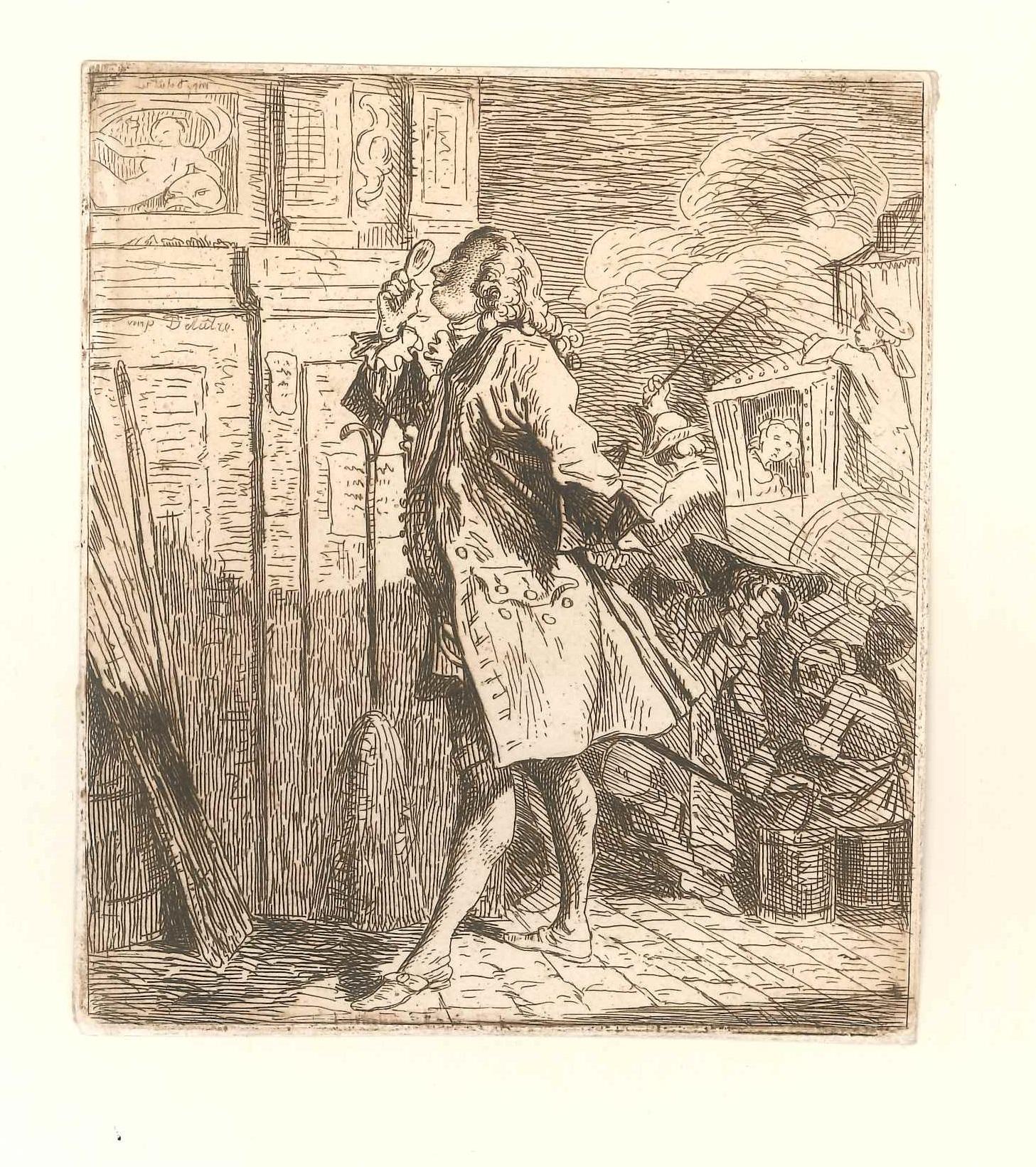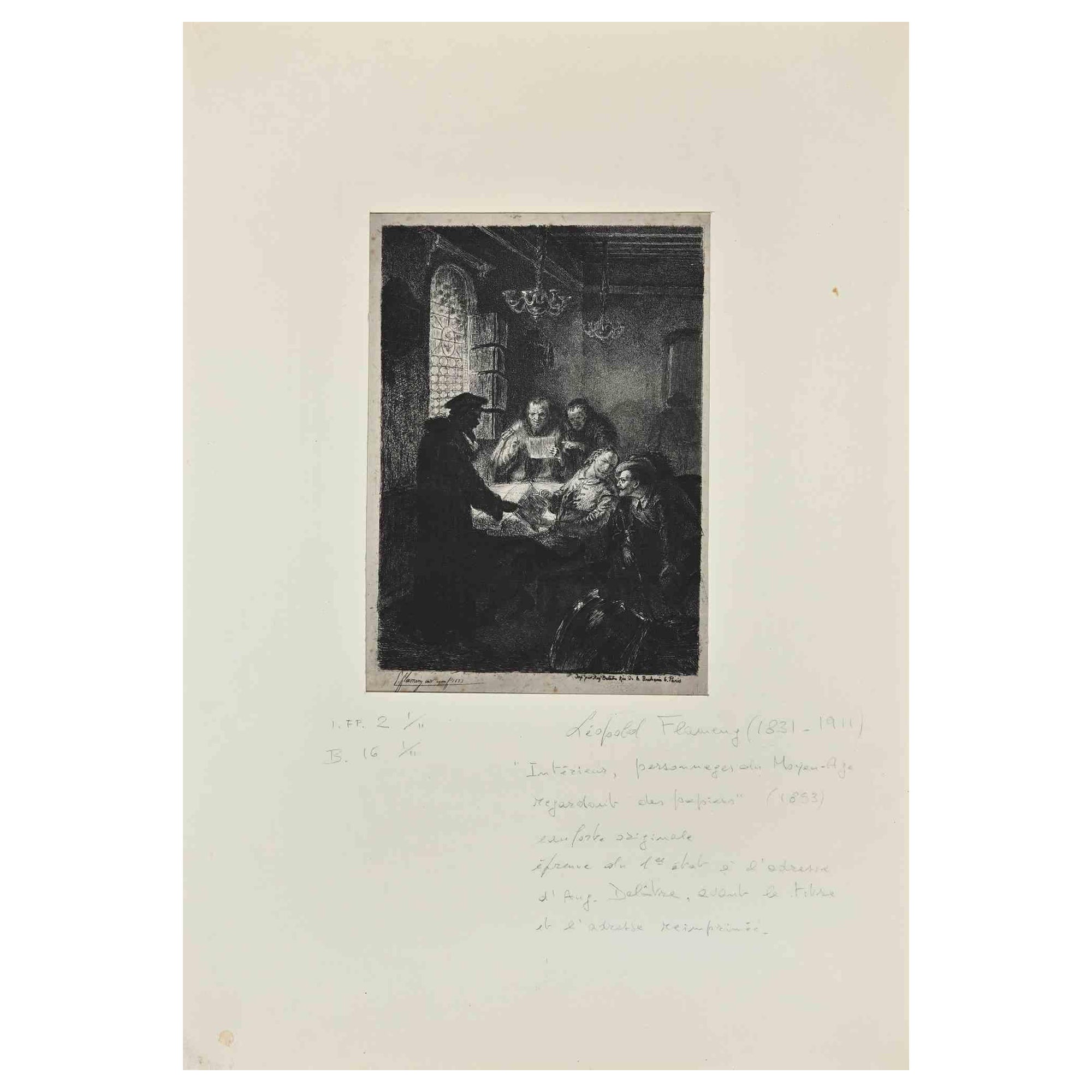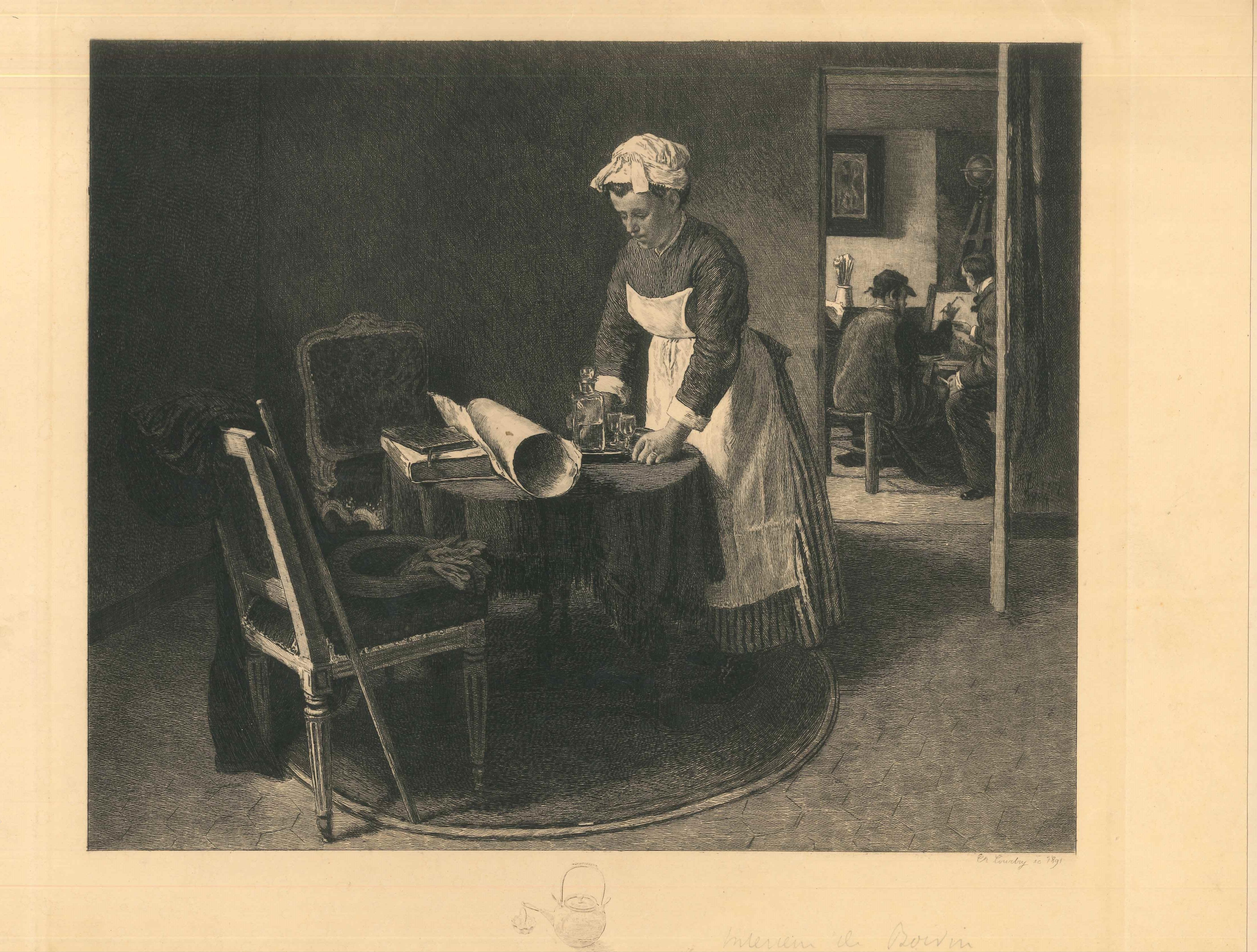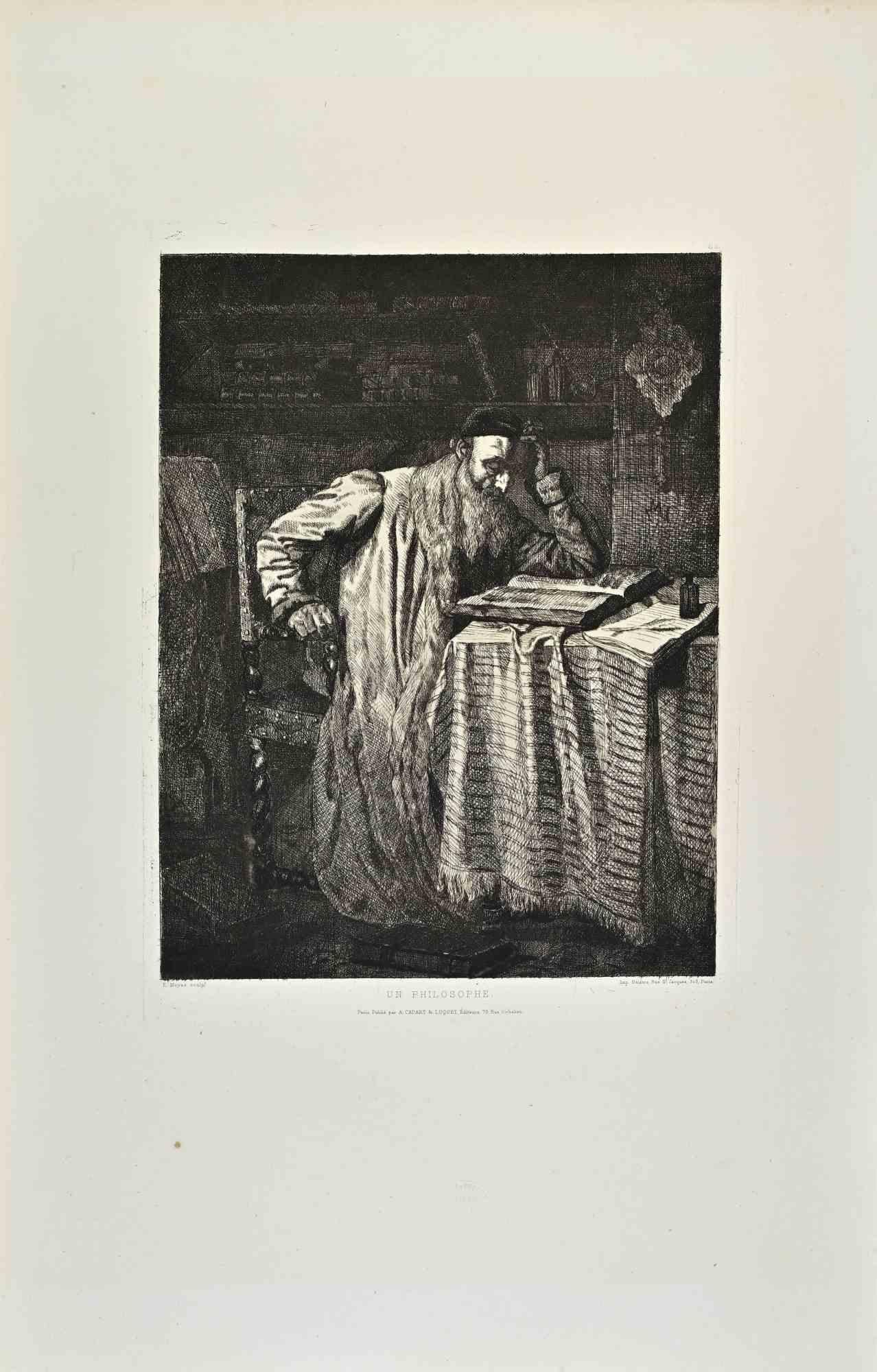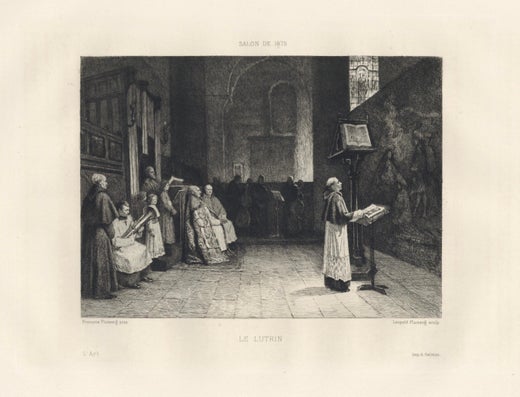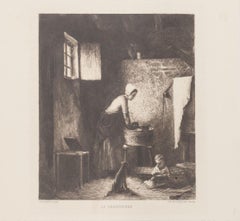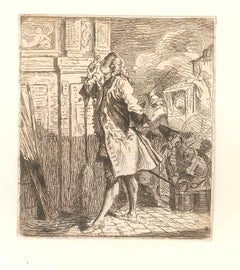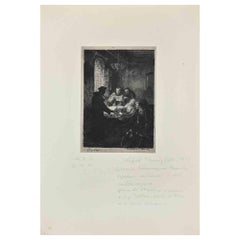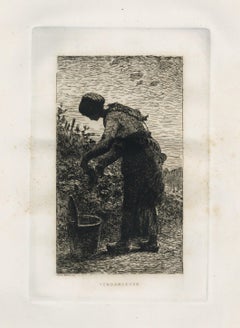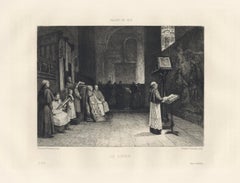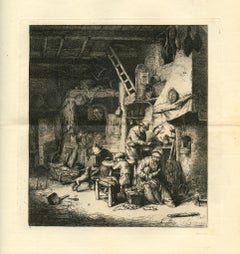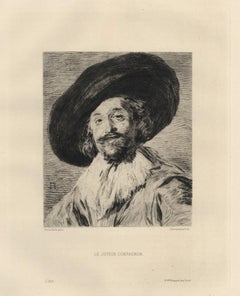Items Similar to Le Peseur d'Or - Original Etching by Léopold Flameng - 1873
Want more images or videos?
Request additional images or videos from the seller
1 of 6
Léopold FlamengLe Peseur d'Or - Original Etching by Léopold Flameng - 18731873
1873
$239.29
£178.64
€200
CA$329.63
A$361.67
CHF 190.51
MX$4,302.47
NOK 2,440.43
SEK 2,228.45
DKK 1,524.08
About the Item
Le Peseur d'Or (The Money Exchanger) is a wonderful black and white etching on wire rod cream-colored paper, realized by Léopold Flameng, an after by the Flemish artist Gabriel Metsu (Leida, 1629 - Amsterdam, 1667).
This is a superb specimen, a print proof before letter, with the title and the inscriptions below the image "Gabriel Metsu pinx/ Léopold Flameng sc.". This original print would have been published later on the Gazette des Beaux-Arts.
This original etching represents a cynic money exchanger, whose only value in life is evil money and does not feel sympathy in front of a crying woman. The deep and vibrant blacks intensify the dramatic atmosphere, demonstrating the superb draftsmanship of the French artist.
In good conditions, except for a usual yellowing of paper and a diffused foxing above all on the lower margin. The area of the etching is also intact.
Leopold Flameng (Brussels, 1831 - Courgent, 1911) was a French artist, well-known for his etchings reproducing works by Jan van Eyck, Leonardo da Vinci, Rembrandt, Ingres and Delacroix, Boccaccio, Paul Scarron, Victor Hugo and François Coppée, producing one-hundred beautiful illustrations.
He at first studied with Luigi Calamatta and Jean Gigoux. His talent as engraver was noticed by Charles Blanc, and his collaboration on the Gazette des Beaux-Arts with his fellow engraver Léon Gaucherel helped to improve the reputation of the publication. He was a medallist at the Universal Exhibition (1878), and was elected member of the Academy of Fine Arts in 1898.
Léopold Flameng (1831, Brussels –1911, Courgent)
The French engraver, illustrator and painter is known for his etchings of works by Jan van Eyck, Leonardo da Vinci, Rembrandt, Ingres and Delacroix. Flameng also illustrated several books on Paris and numerous literary works of classical and contemporary authors, including Boccaccio, Paul Scarron, Victor Hugo and François Coppée.
His first artistic studies were with Luigi Calamatta and Jean Gigoux. His skill as engraver was noticed by Charles Blanc and his collaboration in the Gazette des Beaux-Arts with fellow engraver Léon Gaucherel helped ensure the publication's reputation. He eventually provided one hundred illustrations. He was a medallist at the Exposition Universelle (1878) and was elected a member of the Académie des Beaux-Arts in 1898 .
- Creator:Léopold Flameng (1831 - 1911, French)
- Creation Year:1873
- Dimensions:Height: 13.98 in (35.5 cm)Width: 10.95 in (27.8 cm)Depth: 0.04 in (1 mm)
- Medium:
- Movement & Style:
- Period:
- Condition:Insurance may be requested by customers as additional service, contact us for more information.
- Gallery Location:Roma, IT
- Reference Number:Seller: M-1007261stDibs: LU65034437331
Léopold Flameng
Leopold Flameng was a French artist, well-known for his etchings reproducing works by Jan van Eyck, Leonardo da Vinci, Rembrandt, Ingres and Delacroix, Boccaccio, Paul Scarron, Victor Hugo and François Coppée, producing one-hundred beautiful illustrations. Flameng at first studied with Luigi Calamatta and Jean Gigoux. His talent as an engraver was noticed by Charles Blanc, and his collaboration on the Gazette des Beaux-Arts with his fellow engraver Léon Gaucherel helped to improve the reputation of the publication. Flameng was a medallist at the Universal Exhibition (1878) and was elected member of the Academy of Fine Arts in 1898.
About the Seller
4.9
Platinum Seller
Premium sellers with a 4.7+ rating and 24-hour response times
1stDibs seller since 2017
7,856 sales on 1stDibs
Typical response time: 1 hour
- ShippingRetrieving quote...Shipping from: Monaco, Monaco
- Return Policy
More From This Seller
View AllLa Lessiveuse - Original Etching by A. Decamps & Ch. Bourgeat - 19th Century
Located in Roma, IT
La Lessiveuse is an original print in etching technique on ivory paper, realized by Alexandre Decamps (French Engraver; 1803-1860) and by Ch. Bourgeat, a sculptor.
Good conditions:...
Category
19th Century Landscape Prints
Materials
Etching
Le Message - Original Etching by H.-C. Toussaint after E. Isabey - 1880
By Henri-Charles Toussaint
Located in Roma, IT
Le Message 1880s is an original print in etching technique, realized after Eugène Isabey (Painter and Engraver French ; 1803-1886) by Charles Henri Toussai...
Category
1880s Figurative Prints
Materials
Etching
Lafont de St. Yenne - Original Etching by Léopold Flameng - 1859
By Léopold Flameng
Located in Roma, IT
Lafont de Saint-Yenne is an original black and white etching realized by Léopold Flameng.
This curious artwork, representing a French gentleman, art connesseur, admiring some architectural decoration; was published in "Gazette des Beaux Arts in 1859". A wonderful print, after a satirical drawing by Caylus.
In excellent conditions, including a cream cardboard passepartout, cm 38.5 x 28.5.
Léopold Flameng (1831, Brussels –1911, Courgent)
The French engraver, illustrator and painter is known for his etchings of works by Jan van Eyck, Leonardo da Vinci, Rembrandt, Ingres and Delacroix. Flameng also illustrated several books on Paris and numerous literary works of classical and contemporary authors, including Boccaccio, Paul Scarron, Victor Hugo and François Coppée.
His first artistic studies were with Luigi Calamatta and Jean Gigoux. His skill as engraver was noticed by Charles Blanc and his collaboration in the Gazette des Beaux-Arts with fellow engraver Léon Gaucherel...
Category
1850s Modern Portrait Prints
Materials
Etching
The Poet - Original Etching by Léopold Flameng - 1853
By Léopold Flameng
Located in Roma, IT
"The Poet" is an original etching on paper, realized by Léopold Flameng.
The state of preservation of the artwork is very good.
Signed on the plate.
The artwork represents beautiful poets in a tavern, the etching technique is used.
Léopold Flameng (1831 - 1911): Léopold F. was a French engraver, illustrator and painter. He was born of French parents. He was a medallist at the Exposition Universelle (1878) and was elected a member of the Académie des Beaux-Arts in 1898 . Known for his etchings of works by Jan van Eyck , Leonardo da Vinci , Rembrandt , Ingres and Delacroix , he illustrated several books on Paris and numerous literary works of classical and contemporary authors, including Boccaccio , Paul Scarron , Victor Hugo and François Coppée . He had numerous students, including his son, François Flameng...
Category
1850s Modern Figurative Prints
Materials
Etching
Chez François Bouvin - Original Etching After François Bouvin by Charles Coutry
By Charles Coutry
Located in Roma, IT
Chez François Bouvin is a wonderful etching realized in 1891 by Charles Courtry, after François Bouvin.
This Modern artwork representing a scene of ordinary life, is a beutiful arti...
Category
1890s Modern Interior Prints
Materials
Etching
Un Philosophe - Etching by Edouard Moyse - 1870s
Located in Roma, IT
Un Philosophe is a black and white etching realized by Edouard Moyse (1827-1908) in 1870s.
Titled in the lower.
Image size: 22.5cmx28.5cm.
Good condition.
Not signed.
Realized b...
Category
1870s Modern Figurative Prints
Materials
Etching
You May Also Like
"Vendangeuse" original etching
Located in Henderson, NV
Medium: original etching. François Nicolas Augustin Feyen was known as Auguste Feyen-Perrin. This impression on cream laid paper was printed in 1884 for the "French Etchers" portfoli...
Category
1880s Realist Prints and Multiples
Materials
Etching
"Le Lutrin" etching
By Léopold Flameng
Located in Henderson, NV
Medium: etching (etched by Leopold Flameng after the Francois Fleming painting). This impression on laid paper was printed in 1875 and published in Paris by L'Art. Plate size: 7 1/2 ...
Category
1870s Prints and Multiples
Materials
Etching
"The Family" etching after Van Ostade
By Philip Gilbert Hamerton
Located in Henderson, NV
Medium: etching (etched by Philip Gilbert Hamerton after Adriaen van Ostade). This impression on laid paper was printed in London in 1868 for the rare first volume of Philip Gilbert ...
Category
1860s Prints and Multiples
Materials
Etching
"Le Joyeux Compagnon" etching
Located in Henderson, NV
Medium: etching. Etched by Jules Jacquemart after Frans Hals. This impression on cream laid paper was published in Paris by L'Art in 1880. The image m...
Category
1880s Prints and Multiples
Materials
Etching
"Le Printemps de 1872" original etching
Located in Henderson, NV
Medium: original etching. François Nicolas Augustin Feyen was known as Auguste Feyen-Perrin. This impression on laid paper was printed in 1872 by A. Salmon and published in Paris by ...
Category
1870s Realist Prints and Multiples
Materials
Etching
"The Drawing Lesson" original etching
By Adolphe Lalauze
Located in Henderson, NV
Medium: original etching. This impression on laid paper was printed in 1880 for Philip Gilbert Hamerton's very scarce "Etching and Etchers". Plate size: 7 3/4 x 5 1/2 inches (197 x 1...
Category
1880s Prints and Multiples
Materials
Etching
More Ways To Browse
David L Abel
David Shrigley Black Cats Everywhere
Degas Ballerina Etchings
Degas Signed Lithograph
Dieu Et Mon Droit
Distorted Face Paintings
Donna Evans
Earl Washington
Eduardo Paolozzi On Sale
Edward Borein Etching
Edward Millman
El Cid
Engravings Shakespeare
Ernie Barnes On Sale
Erte Autumn
Erte Four Seasons
Erte Letter D
Erte Letter L
